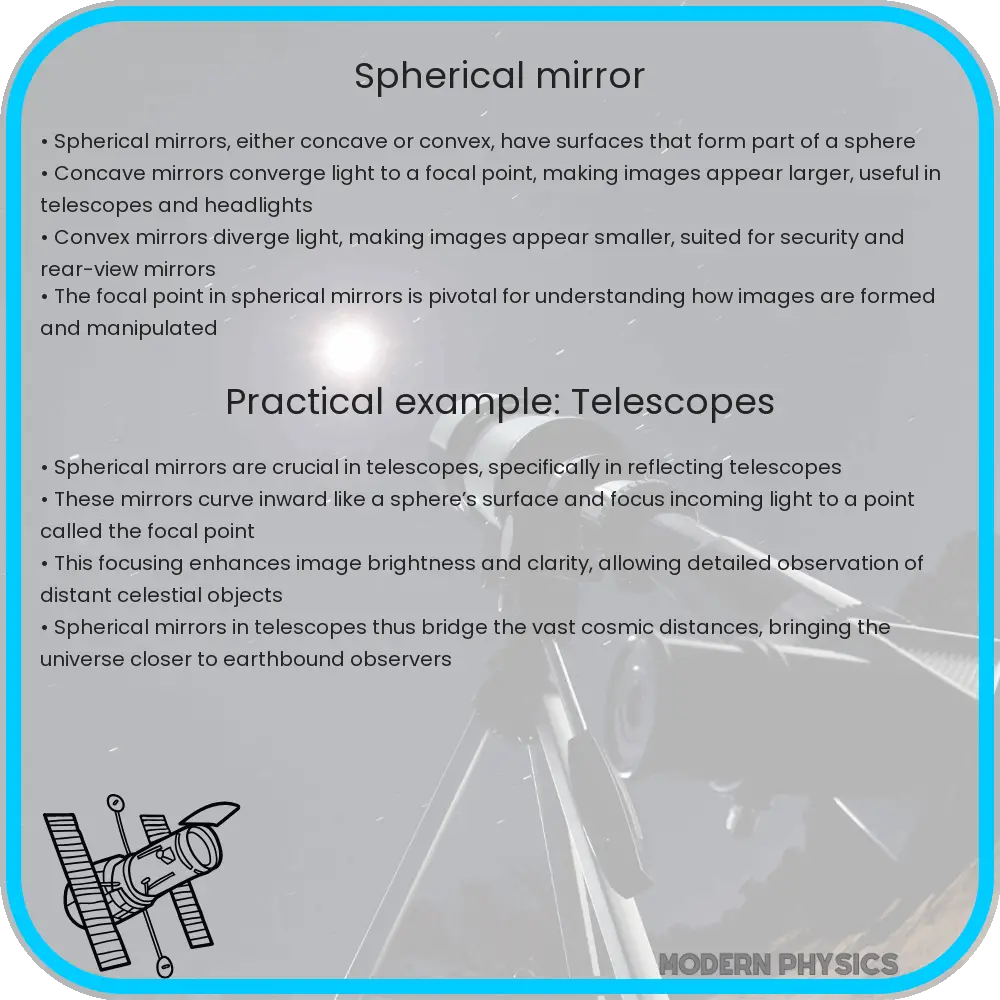Explore the fascinating world of spherical mirrors, covering types, curvature, image formation, reflection principles, and practical applications.

Understanding Spherical Mirrors: Curvature, Image Formation, and Reflection
Spherical mirrors are a fundamental component in the field of optics, widely used in everything from telescopes to everyday mirrors. Their unique properties stem from their shape, which is part of a sphere. There are two main types of spherical mirrors: concave and convex, each with distinct characteristics and applications. In this article, we delve into the concepts of curvature, image formation, and reflection as they pertain to spherical mirrors.
Types of Spherical Mirrors
The two types of spherical mirrors – concave and convex – differ in the way they reflect light. Concave mirrors are curved inwards, resembling a portion of the interior of a sphere. They are known for their converging effect on light rays, which is crucial in applications requiring image magnification. On the other hand, convex mirrors bulge outwards, akin to the exterior of a sphere. They diverge light rays, making them useful for wider field of view applications, such as in vehicle rearview mirrors.
Curvature and Focal Length
The curvature of a spherical mirror is closely tied to its focal length. The focal length, denoted as \( f \), is the distance between the mirror’s surface and its focal point. This point is where parallel rays of light either converge (in a concave mirror) or appear to diverge from (in a convex mirror). The relationship between the radius of curvature (\( R \)) and the focal length is given by the formula \( f = \frac{R}{2} \). This relationship is pivotal in determining how images are formed by these mirrors.
Image Formation in Spherical Mirrors
Image formation in spherical mirrors is governed by the principles of reflection. In a concave mirror, when an object is placed at different distances from the mirror, the nature of the image formed varies. It can be real or virtual, magnified or diminished, depending on the object’s distance relative to the focal point. In contrast, convex mirrors always form virtual, diminished, and upright images regardless of the object’s position.
Understanding the image characteristics is crucial for practical applications. For instance, concave mirrors are used in telescopes and headlights for their ability to converge light, thereby forming a clear and distinct image. Convex mirrors, with their diverging nature, are ideal for security mirrors and rearview mirrors in vehicles, offering a broader perspective.
The properties of spherical mirrors make them indispensable in various fields, from scientific research to daily life utilities. Their ability to manipulate light through curvature and reflection principles enables a wide range of functionalities, underscoring their importance in optical technology.
Ray Diagrams and Image Characteristics
Ray diagrams provide a visual representation of light reflection and image formation in spherical mirrors. They are crucial for understanding how images are formed. In a ray diagram, a few specific rays are drawn, which obey the laws of reflection, and their intersection points help determine the position and nature of the image formed. For concave mirrors, ray diagrams can illustrate the formation of real or virtual images, while for convex mirrors, they consistently depict virtual images.
Mathematical Formulation in Mirror Optics
The mathematical analysis of image formation in spherical mirrors is facilitated by the mirror equation: \( \frac{1}{f} = \frac{1}{d_o} + \frac{1}{d_i} \), where \( f \) is the focal length, \( d_o \) is the object distance, and \( d_i \) is the image distance. This equation, along with the magnification equation \( m = -\frac{d_i}{d_o} \), where \( m \) is the magnification, helps in calculating the position and size of the image. These formulas are fundamental in designing optical devices involving spherical mirrors.
Applications of Spherical Mirrors
Spherical mirrors find applications in various fields. Concave mirrors are commonly used in astronomical telescopes, reflecting telescopes, and vehicle headlights. They are also employed in solar furnaces and shaving mirrors. Convex mirrors, with their wide field of view, are essential in vehicle rearview mirrors, security mirrors in stores, and as part of street intersection mirrors for traffic safety. The versatility of these mirrors in different applications highlights their importance in both scientific and everyday contexts.
Challenges and Limitations
Despite their wide range of applications, spherical mirrors have limitations. One significant issue is spherical aberration – a distortion that occurs when rays far from the principal axis do not converge at the same point, leading to a blurred image. Advanced technologies, like parabolic mirrors, are used in some applications to overcome this limitation.
Conclusion
Spherical mirrors are a cornerstone in the field of optics, providing an essential means of manipulating light. Understanding their properties, such as curvature, focal length, and the way they form images, is fundamental in numerous applications, from scientific instruments to everyday objects. While they have some limitations, their utility in diverging and converging light makes them indispensable. The study of spherical mirrors not only deepens our comprehension of optical principles but also enhances the capabilities of various technologies that shape our modern world.
